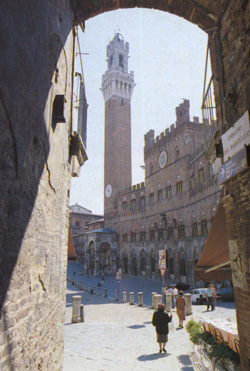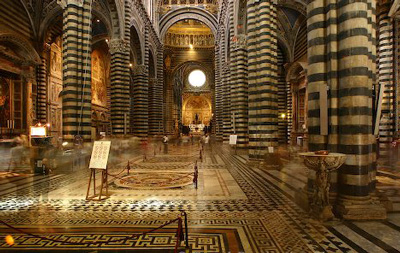Siena
Siena is like a casket full of treasures, some extremely famous - such as the Duomo or the Piazza del Campo - others less famous but still surprising like Fontebranda.
Siena was an Etruscan city before becoming Roman with the name of Saena Iulia. The initial nucleus of Castelvecchio grew and became rich thanks to the strategic of Siena on the Via Franchigena. In the 13th Century Siena was a financial centre of international importance and it had a larger population than Rome. The 13th and 14th Centuries were the golden eras, the period in which the city became full of monuments and works of art. Then the plague arrived in 1348 which killed more than half the population and with it all the dreams of expansion.
Siena remained an independent republic until 1555 when it became part of the Grand Duchy of Tuscany until 1860 when, with a plebiscite, Tuscany chose to become part of the Italian State.
The social life is very intense in Siena; dinners, exhibitions, conferences comedies, concerts... but most of all there is an aspect that distinguishes Siena from other towns: the Palio and the Contrade. Not all the Sienese belong to a Contrada, but a large part do. The new-born enters the Contrada where his parents live, receives the Baptism of the Contrada and therefore becomes part of the “people”, that is a large family with very strong bonds of solidarity.
The marvellous pageant and the races on 2nd July and 16th August are only a part of the world of the Palio. They are the festivals which celebrate our past, therefore do not make fun of them the Palio is a serious thing for them!
The Palazzo Pubblico
The Paazzo Pubblico palace, facing the Torre del Mangia in Piazza del Campo, houses the offices of the local administration of the city of Siena and of the Civic Museum, it is one of the most significant examples of civil Gothic architecture. The most important hall of the museum are the Hall of the Globe (Sala del Mappamondo) with the famous 13th Century frescoes portraying Majesty and Guidoriccio da Fogliano made by Simone Martini, and the Hall of Peace (Sala della Pace), frescoed with The Allegory of the Good and Bad Government by Ambrogio Lorenzetti, in which the city and the countryside of Siena in the Middle Ages are realistically represented.
The Torre del Mangia
 The Torre del Mangia tower owes its strange name to the bell-ringer’s nickname, called “Mangiaguadagni” (Money-eater), who in 1347 was in charge of ringing the bells to sound the hours. 400 steps lead to the top of the tower, 87 metres high. It overlooks the Piazza del Campo square which is, just like in the Middle Ages, the heart of Siena, always the meeting point of the population during celebrations and events. The Torre del Mangia tower owes its strange name to the bell-ringer’s nickname, called “Mangiaguadagni” (Money-eater), who in 1347 was in charge of ringing the bells to sound the hours. 400 steps lead to the top of the tower, 87 metres high. It overlooks the Piazza del Campo square which is, just like in the Middle Ages, the heart of Siena, always the meeting point of the population during celebrations and events.
The Cathedral of Siena
 The Duomo in Siena is one of the most beautiful churches in Italy and it dominates the square with its covering of white and black marble and its Romanesque-Gothic facade. Works started in in 1229 and were finalized at the end of the following century. The dome was completed in 1263. The bell tower, which stands almost 77 metres high, was finished in 1313. The works of the most important Italian sculptors from the Middle Ages to the Baroque, such as Nicola Pisano, Donatello, Michelangelo and Gian Lorenzo Bernini are kept inside the cathedral. On the right-hand side there is the Chapel of the Vow, thus called due to the presence of the 13th Century painting called Madonna of the Vow in front of which the Sienese still go to pray for “graces”. On the opposite side there is the Piccolomini Library. Built in 1492, it was entirely frescoed by Pinturicchio at the beginning of the 16th Century. He portrayed the most important events in the life of Enea Silvio Piccolomini, Pope Pius II, in 10 paintings, probably also helped by the young Raffaello. The Duomo in Siena is one of the most beautiful churches in Italy and it dominates the square with its covering of white and black marble and its Romanesque-Gothic facade. Works started in in 1229 and were finalized at the end of the following century. The dome was completed in 1263. The bell tower, which stands almost 77 metres high, was finished in 1313. The works of the most important Italian sculptors from the Middle Ages to the Baroque, such as Nicola Pisano, Donatello, Michelangelo and Gian Lorenzo Bernini are kept inside the cathedral. On the right-hand side there is the Chapel of the Vow, thus called due to the presence of the 13th Century painting called Madonna of the Vow in front of which the Sienese still go to pray for “graces”. On the opposite side there is the Piccolomini Library. Built in 1492, it was entirely frescoed by Pinturicchio at the beginning of the 16th Century. He portrayed the most important events in the life of Enea Silvio Piccolomini, Pope Pius II, in 10 paintings, probably also helped by the young Raffaello.
The Facciatone and Piazza Jacopo della Quercia
The square just besides the Duomo is called Piazza Jacopo della Quercia. From the dimensions of the pillars and the Facciatone (Huge Facade) of the Duomo , we can today see that it should have been much larger. But the Sienese dream of building the largest cathedral in the world vanished due to the enormity of the cost, the technical difficulties given by the ground not able to support such a structure and the spreading of the Black Death (plague) in 1348.
From the Facciatone, which is reached from the Museo dell’Opera, there is an extraordinary view upon the city. Amongst the masterpieces in the Museum there are the sculptures from the facade of the Cathedral made by Giovanni Pisano as well as the Majesty and the Stained Glass by Duccio di Buoninsegna, the founder of the Sienese school of painting.
The museum of Santa Maria della Scala
The Museum Complex of Santa Maria della Scala was built in front of the Duomo in the 9th Century. It was at the time one of the first European hospitals, with its own organization to receive pilgrims, help the poor and the abandoned children. Transformed today in a museum complex, it conserves rooms which witness the history of this institution and the city. From the underground labyrinths hollowed out from the tufa where extremely interesting archaeological findings are displayed, you pass to the superior rooms, such as the Pilgrims’ Hall, where the history and the purposes of the hospital are shown.
|

